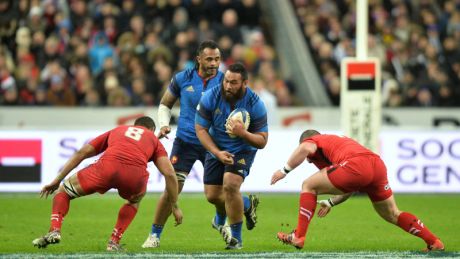
Over the past few weeks, rugby's hardest hitting monsters have arrived in England to push their terrifying athletic mettle to its limits. They have powered, zipped, crushed and bludgeoned their hearts out for the right to be crowned world number 1, to lift that glorious trophy and to say 'we are the fastest, most powerful players on planet earth'. Sound intimidating? Turns out the intense training they put themselves through is not complicated. These massively strong men follow simple routines and eat cleanly, that's all there is to it. And now you can enjoy the same atheticism thanks to Virgin Active's top personal trainers who have taken a look at the different physical requirements and developed some workouts to help us get in pro rugby player shape.
1. The Strength of Hookers
Hookers need to have both muscle mass and strength. And plenty of it. Everywhere. These guys play an essential role in all stages of the game, from scrummaging to tackling, to mauling and running, hookers are always in the thick of the action.
Luke Donovan from Virgin Active reccomends doing this high-intensity circuit as many times as possible in 10 minutes:
5x unilateral floor press with ball each side (lay on your back and with one hand, push a medicine ball in the air as explosively as possible then lower it back down again)
5x wide grip pull ups (that's palms facing outwards)
5x unilateral bench row each side
5x shoulder press from floor
Get the Coach Newsletter
Sign up for workout ideas, training advice, reviews of the latest gear and more.
2. The Power of Props
Power is an essential part of the game. However props need it more than anyone. Handing off opponents, putting in big hits and pushing and lifting team mates are all examples of the heavily explosive movements, required by these chunky players.
Luke Donovan from Virgin Active recommends doing this ‘Power Circuit’ as many times as possible in 8 minutes:
7x unilateral landmine press each side (attach barbell to holder on floor, load up the top end closest to your hand then press the bar forward. Lower and repeat)
7x ball slams to floor
7x squat into box jump
7x dumbbell punch
3. The Fitness of Fly Halves
Fly Halves are renowned for their fitness and stamina, meaning they are always in the right place at the right time. Their muscles are required to keep moving for 80 minutes and vital organs like the heart and lungs are expected to keep the body pumping with enough oxygen and blood to last the duration of the match.
Luke Donovan from Virgin Active recommends repeating this endurance circuit as many times as possible in 8 minutes to help improve match fitness and stamina.
Watt bike 25 second sprint
5x jump to pull up
Watt bike 25 second sprint
7x kettlebell suitcase deadlift
‘Get the Legs of a Forward’
Strong legs are the force behind the push. Vital for breaking through tackles, winning a scrum or pushing a maul, legs are essential for all rugby players, especially forwards.
To build strength in the legs, Alex Davies recommends front squats and lunges.
Alex says: “When doing your squats, lunges and other leg exercises start slowing down your reps to at least five seconds. If you cannot do both motions that slowly then at least perform the negative as slowly as you can. So, if you are doing a squat, make the squatting down part five seconds long. This will boost your progress very quickly’’.
‘Get the Width of a Winger’
Gillian Reeves, National Group Exercise Manager recommends weight training mixed with yoga and cardio for a strong powerful back, vital for the agile, powerful movements performed by wingers.
Gillian says: “Tone your back with regular cardio sessions combined with weight training sessions and Yoga. Any weights based exercise that focuses on a pulling movement such as rowing will work the back. Try out a Vinyasa sequence to strengthen your back as well as encouraging torso mobility."
Upward Facing Dog: “The upward facing dog move is a powerful back strengthening posture in the vinyasa sequence; from lying face down on the floor, take your hands under your shoulders and lift your head, shoulders and torso upwards, clenching your buttocks and straightening your legs and arms. Aim to maintain a gap between the shoulders and ears and your hands directly under the shoulders.’’
Sam Razvi wrote for Men’s Fitness UK (which predated and then shared a website with Coach) between 2011 and 2016.
